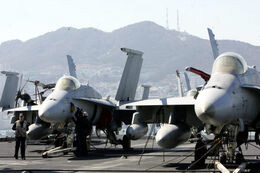hankyoreh
Links to other country sites 다른 나라 사이트 링크
U.S.-S.K. military exercise expansion draws ire from North

North Korea and the U.S. stepped up their war of words surrounding the military exercises jointly participated in by the U.S. and South Korea. This is in stark contrast to the diplomatic climate seen at the six-party talks ongoing in Beijing.
The object of contention is the annual RSOI (Reception, Staging, Onward Movement and Integration) war preparedness drills run by the U.S. Forces Korea.
The six-party forum commenced again in Beijing on December 18 after falling apart 13 months ago.

On December 12, the commander of the U.S. military in South Korea, General Burwell B. Bell, said that the U.S. will bring troops onto the peninsula to participate in military exercises early next year at brigade levels, according to participants of a meeting with General Bell.

The RSOI drills began in 1994, just after the "Team Spirit" joint military exercise was scrapped. The two exercises are very different: Team Spirit focused on wartime mobilization exercises in which real equipment and troops already existing on the peninsula were joined by enforcements of U.S. troops from abroad. But with the current RSOI drill, the U.S. and South Korea focused mainly on computer simulations rather than deploying actual troops. U.S. troops have been sent from the U.S. mainland to join the drill, but their scale was below battalion-level. If, according to General Bell’s comments, forces were sent from the U.S. mainland and deployed in the drill at brigade levels - larger than a battalion - it would mark the largest-scale dispatch from the U.S. mainland since the end of Team Spirit, in which the number of U.S. forces joining from abroad equaled two to three divisions, with one division being larger than either a battalion or a brigade.
The level of strength of the war preparedness drills jointly conducted between the U.S. and South Korea - including "Eagle" and "Ulji Focus Lens" - is expected to increase next year. The Eagle exercise has been conducted since 1961, and integrated into the RSOI since 2002, which was conducted in late March each year.
The Ulji Focus Lens joint exercise is slated for expansion, as South Korea has planned to step up its preparedness level following North Korea’s October 9 nuclear test. In addition, another joint military wartime execution plan, "OP 5027," is expected to be revised in the face of the North’s test and a realignment of U.S. forces in the region.
The North’s Committee for the Peaceful Reunification of the Fatherland accused the U.S. commander’s remarks of adding fuel to war scenarios on the Korean peninsula. North Korea also said it would cope with such a stance using what it called its available measures of self-defense. Pyongyang urged the U.S. to scrap such military exercises, especially amid the ongoing six-party talks to persuade Pyongyang to give up its nuclear weapons program, the committee said.
Baek Seung-ju of the Korea Defense Research Institute, said, "We have no choice but to expand joint military exercises between South Korea and the U.S. in an effort to brace for the potential nuclear threat from the North and the changing situation caused by the wartime operational control transfer of the South Korea military from the U.S. to South Korea." The researcher said it was customary for North Korea to criticize the joint military exercise expansion as a U.S. conspiracy to try to invade the North.
However, Dongguk University professor Lee Cheol-ki said that North Korea halted inter-Korean talks in the 1990s, citing the Team Spirit exercises between South Korea and the U.S. "Large-scale military exercises may have a negative impact on the six-party talks," Lee said.
Please direct questions or comments to [englishhani@hani.co.kr]
Editorial・opinion
![[Editorial] Perilous stakes of Trump’s rhetoric around US troop pullout from Korea [Editorial] Perilous stakes of Trump’s rhetoric around US troop pullout from Korea](https://flexible.img.hani.co.kr/flexible/normal/500/300/imgdb/original/2024/0509/221715238827911.jpg) [Editorial] Perilous stakes of Trump’s rhetoric around US troop pullout from Korea
[Editorial] Perilous stakes of Trump’s rhetoric around US troop pullout from Korea![[Guest essay] Preventing Korean Peninsula from becoming front line of new cold war [Guest essay] Preventing Korean Peninsula from becoming front line of new cold war](https://flexible.img.hani.co.kr/flexible/normal/500/300/imgdb/original/2024/0507/7217150679227807.jpg) [Guest essay] Preventing Korean Peninsula from becoming front line of new cold war
[Guest essay] Preventing Korean Peninsula from becoming front line of new cold war- [Column] The state is back — but is it in business?
- [Column] Life on our Trisolaris
- [Editorial] Penalties for airing allegations against Korea’s first lady endanger free press
- [Editorial] Yoon must halt procurement of SM-3 interceptor missiles
- [Guest essay] Maybe Korea’s rapid population decline is an opportunity, not a crisis
- [Column] Can Yoon steer diplomacy with Russia, China back on track?
- [Column] Season 2 of special prosecutor probe may be coming to Korea soon
- [Column] Park Geun-hye déjà vu in Yoon Suk-yeol
Most viewed articles
- 1Nuclear South Korea? The hidden implication of hints at US troop withdrawal
- 2[Editorial] Perilous stakes of Trump’s rhetoric around US troop pullout from Korea
- 3‘Free Palestine!’: Anti-war protest wave comes to Korean campuses
- 4Korea likely to shave off 1 trillion won from Indonesia’s KF-21 contribution price tag
- 5In Yoon’s Korea, a government ‘of, by and for prosecutors,’ says civic group
- 6With Naver’s inside director at Line gone, buyout negotiations appear to be well underway
- 7[Photo] ‘End the genocide in Gaza’: Students in Korea join global anti-war protest wave
- 8Seoul getting its first-ever vertical farm
- 9‘We must say no’: Seoul defense chief on Korean, USFK involvement in hypothetical Taiwan crisis
- 10Behind-the-times gender change regulations leave trans Koreans in the lurch